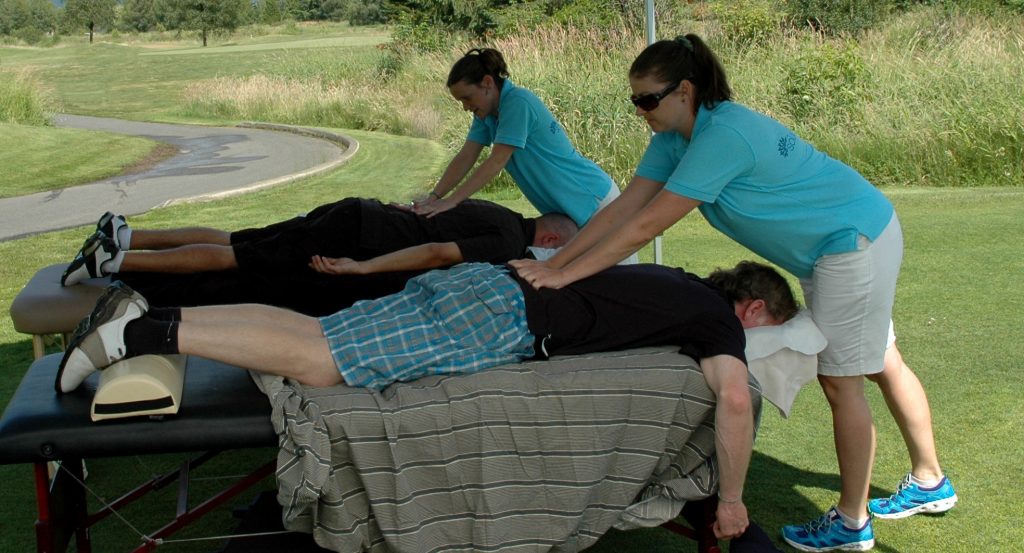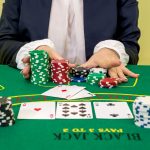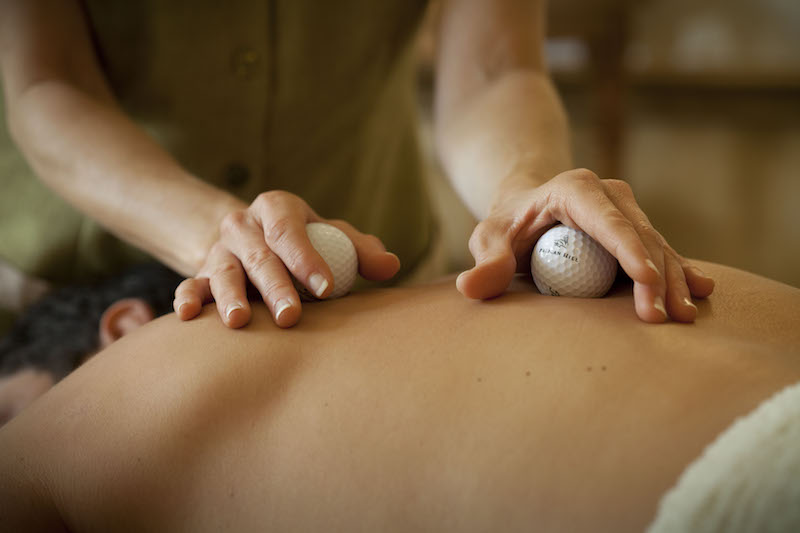It’s also called “massage for golfers.” Golf massage is a type of massage treatment that is specially designed to help players with their unique needs and problems. Power, accuracy, and flexibility are all needed to play golf. The repeated movements of the golf swing can make muscles tight, cause weaknesses, and increase the risk of injury. By increasing range of motion, making muscles more flexible, increasing blood flow, and decreasing muscle soreness, golf massage aims to alleviate these problems. By focusing on key muscle groups like the neck and shoulder muscles, hip flexors, and rotator cuff muscles, golf massage can help players improve their swing and lower their risk of getting hurt again. Whether you’re a professional golfer or just like to play for fun, getting a golf massage can help you play better and feel better overall.
Advantages of a Golf Massage
Golf is a sport that takes accuracy and skill, and players often do the same things over and over, which can be hard on their bodies. This is where golf massage comes in. It can help players stay in great shape on and off the course in many ways.
One of the best things about golf massage is that it can help keep you from getting hurt. Golfers can lower their chance of muscle cramps, stress injuries, and bad posture by getting massages on a regular basis. It’s also been shown that massage can help golfers’ balance, which can help them make their swings more powerful and smooth.
Golf massage can help golfers avoid injuries and improve their range of motion and flexibility. Regular lessons can help players make their hips and shoulders more flexible, which makes it less likely that these areas will get stiff during play. This wider range of motion can make the swing easier and the player move more efficiently during the game.
Another benefit of golf massage is that it can help with pain. This specific type of massage works on the layers of muscles that are used in the golf swing to ease soreness and tightness. People who play golf can get relief from common causes of pain by working on muscles like the hip flexors, rotator cuff, neck, and shoulder.
Lastly, golf massage improves circulation, which means it brings more fresh blood to muscles and removes waste from the body. This helps muscles heal faster from tiredness and lowers the chance of getting hurt again.
Types of Golf Massages
Golf massage includes a variety of massage methods that are designed to help players. These massages are designed to meet the specific goals and physical demands of the sport. A deep tissue massage is a popular type of golf massage. It works on the lower layers of muscles to relieve stress and improve range of motion. Another popular choice among golfers is sports massage, which helps keep them from getting hurt and improves their performance. In golf massages, trigger point treatment is often used to loosen up knots and tight spots on the body. Myofascial release is another technique that may help some players. This method includes gently stretching the connective tissue to make muscles more flexible. Because there are many massage methods, players can pick the one that fits their needs and tastes best to improve their game and avoid getting hurt.

The Swedish massage
A lot of people like Swedish massage, which is also called relaxation massage. Its main goals are to ease muscle stress, encourage relaxing, and boost circulation. Long, smooth, flowing strokes and deep finger pressure are used in this type of massage to target areas of stress and loosen up muscle knots.
Swedish massage can help you relax deeply and feel less stressed, which is one of its main benefits. This type of massage uses soft, regular moves that help to calm the nervous system and start the body’s relaxed reaction. This makes you feel calm and peaceful.
Swedish massage not only relaxes you, but it also makes your blood flow better. When strokes and pressure are used together, they help to improve blood flow. This brings oxygenated blood to muscles and important organs and gets rid of metabolic waste. This better mobility can help your health and well-being as a whole.
One more benefit of Swedish massage is that it can help you move around better. By easing muscle tightness, this type of massage can help make you more flexible and open up your range of motion. It can be especially helpful for people who have stiff muscles, bad posture, or the results of doing the same thing over and over again.
Deep Tissue Massage
In golf massage treatment, deep tissue massage is often used to relieve ongoing stress and speed up muscle healing. This type of massage works on the deeper layers of muscle and connective tissue to help with pain and make muscles healthier.
The professional uses slow strokes and deep finger pressure in a deep tissue massage to loosen up muscles and relieve stress. By putting hard pressure on the muscles below, the therapist can work on areas of long-term stress or adhesions.
In deep tissue massage, slow strokes help to stretch and strengthen muscle fibers, which makes the blood flow and circulation better. This helps get rid of cellular waste in the muscles, which makes them less sore and tired.
Deep tissue massage works on more than just easing muscle tightness. It also works on the connective tissue that supports and wraps around the muscles. This type of massage can help muscles work better and move more freely by releasing tight spots in the connective tissue.
Deep tissue massaging is a great way for players to ease the muscle tightness that comes from the strong force and repeated movements of the swing. It can help loosen up tight muscles, lower the risk of getting hurt, and make your golf move smoother and more effective.
Sports Massage
Sports massage is a specific type of massage treatment that can help golfers in many ways. Getting a sports massage on a regular basis can help you become more flexible, avoid injuries, and play better golf overall.
The massaging of deep tissues is an important part of sports massage. To get deep into the muscles with this method, you use hard pressure and slow strokes. A sports massage expert can relieve stress, loosen up tight muscles, and work on adhesions or knots that may have formed in the muscles by applying this much pressure.
A sports massage includes both deep muscle treatment and specific stretching methods. The range of motion and flexibility of your muscles get better with these stretches. Both of these things are very important for players. By getting more flexible, players can make their swings full and open, which lets them hit more strong and accurate shots.
A method used to reduce soreness is another important part of sports massage for players. These methods can help lower inflammation in the joints and muscles, which can ease pain and speed up healing. Golfers can keep playing at their best by lowering inflammation and lowering their chance of overuse injuries.
In general, sports massage is a very helpful form of rehab for players. Sports massage can make you more flexible, keep you from getting hurt, and help you do better on the golf course by mixing deep muscle treatment, focused stretching, and anti-inflammatory methods.
Trigger Point Therapy
There are many benefits for golfers from trigger point treatment, a type of massage therapy that works very well. This special method targets tight muscles in certain areas and breaks knots and trigger points, which eases pain and stress.
Tense muscles are common for golfers, which can make them less effective and raise their risk of getting hurt. Trigger Point Therapy focuses on these tight spots and uses deep pressure to loosen up the muscles’ knots and trigger points. This not only eases the pain right away, but it also makes muscles more flexible and increases their range of motion.
Trigger Point Therapy works on these areas to loosen up tight muscles, help muscles stretch in a healthy way, and make movement better. This specific muscle release can help players improve their game by making their swing more smooth and effective.
Golfers can get a lot of pain relief, better muscle movement, and better success by adding Trigger Point Therapy to their practice. Golfers can reach their goals on the course with the help of Trigger Point Therapy, whether they are healing from an accident or just want to get in better shape.
Myofascial Release
A method called Myofascial Release is very good at helping players with muscle aches, cramps, and even neck problems like degenerative arthritis and spine stenosis. This method of therapy is meant to target and relieve tightness in the fascia, which is the elastic tissue that supports and wraps around the muscles.
Myofascial Release can help golfers feel less pain and move around better by working on the fascia. This improves their general performance. Long-term pressure, stretching, and rolling moves are used in this method to loosen up the fascia and make it less tight. In turn, this lets the muscles move easily and work at their best.
Myofascial Release can help golfers avoid muscle aches, make their muscles more flexible, and improve their swing for a better, more powerful game. Golfers can improve their range of motion, avoid muscle abnormalities, and lower their risk of injury by letting go of tightness in the fascia.
Myofascial Release is a focused and effective way for players to reduce pain, regain proper muscle function, and improve their performance on the course, whether they are dealing with muscle tightness, strains, or neck illnesses. Professional players can benefit from this type of treatment and play their best on the green with the help of a skilled therapist.
Shiatsu
Shiatsu massage is a type of healing massage that can help golfers in many ways. Shiatsu is a Japanese technique that uses deep steady and regular pressure on certain spots on the body to help people rest, ease muscle tightness, and feel better overall.
Shiatsu is especially good for golfers because it can help them improve their range of motion. Shiatsu helps to release physical and spiritual blocks by focusing on areas that are tight and limited in motion. This makes it easier to move during the golf swing. Golfers can make a stronger and more efficient swing with this wider range of motion, which helps them do better on the course.
Neck problems happen a lot to players. They can be caused by strained muscles or degenerative diseases like arthritis. Deep pressure and massage methods can help with these problems when used on the neck and the areas around it during shiatsu. This helps loosen up tight muscles, lower inflammation, and improve blood flow to the hurt areas, which makes the neck feel better and work better.
Manual Lymphatic Drainage
A special kind of massage called manual lymphatic drainage can help golfers a lot by making their blood flow better and easing muscle pain. Manual lymphatic drainage works on the lymphatic system, while other massage methods may focus on moving muscles around.
Getting rid of waste and toxins from the body is the job of the lymphatic system. It also helps keep the immune system in check. If the lymphatic system isn’t working properly or is moving too slowly, toxins and inflammation can build up, which can make players less effective and more likely to get hurt.
Soft, regular touches are used to strengthen and improve the lymphatic system during a hand lymphatic drainage practice. To get lymph fluid moving through the body more efficiently, the therapist uses light pressure and moves their hands in a specific rhythm. By doing this, the massage helps get rid of any lymph fluid that isn’t moving, as well as toxins and inflammation. This makes it easier for fresh, oxygenated blood to flow through the body.
Manual lymphatic draining is good for players in many ways. To begin, better circulation helps keep muscles from getting tired, which speeds up healing and makes it easier to keep going on the course. Manual lymphatic drainage can also help reduce pain and soreness by getting rid of toxins and inflammation. This makes you more comfortable during and after a round of golf. Lastly, making the lymphatic system work better can improve range of motion, which can help players make a smoother and stronger swing.
An excellent way for golfers to improve their game and avoid injuries is to include hand lymphatic drainage in their practice. This massage method can make a player feel better generally and make the game more fun by improving circulation, easing muscle tiredness, and supporting a healthy lymphatic system.
Techniques Used in Golf Massage
Golf massage uses a variety of techniques to focus on certain parts of the body in order to help players perform better and avoid accidents. Deep tissue massage is a popular method. It uses hard pressure to relax muscles and boost blood flow, which makes muscles more flexible and lowers the risk of muscle cramps. Another method is sports massage, which focuses on increasing range of motion and fixing flaws in posture that come from doing the golf swing over and over again. This kind of treatment can help players improve their swing and make it more strong. It can also lower their risk of elbow, shoulder, and rotator cuff problems. When these methods are used and the massage is tailored to the golfer’s specific needs, golf massage can improve their ability to move and perform overall on the course.

Effleurage and Petrissage
Effleurage and Petrissage are two massage methods that are often used in golf massage to help players in certain ways. Light to medium pressure is used for long, sweeping strokes along the length of the muscle during effleurage. This method helps the blood flow and relaxes the muscles so they are ready for more intense work.
Petrissage, on the other hand, uses hard pressure to rub, roll, and squeeze the muscles. It eases muscle strain, makes muscles more flexible, and lessens muscle pain. This method works on the lower layers of muscles and can help players whose muscles and joints are tight.
Effleurage is a technique that is often used to warm up the muscles and get blood flowing during a golf massage. This method helps the muscles get more oxygen and get rid of cellular waste, which makes action better overall. The therapist will then use Petrissage to loosen up any tight muscles, make the range of motion better, and lower the risk of harm.
For Effleurage to be done right, the therapist should use their hands or fingers to make light, flowing strokes along the muscle. They move toward the heart, which is where the blood flows. The therapist presses on the muscles with their hands, thumbs, and fingers to rub and stretch them. This method can be changed depending on how comfortable the player is and where their muscles are tense.
Compression Strokes and Movements
A big part of golf massage that aims to improve circulation and get rid of toxins in the muscles is using strokes and moves that press on the muscles. These methods not only help get fresh blood to the muscles, but they also help the muscles heal faster and feel less stiff and painful.
Different compression strokes and moves are often used in golf massage to work on particular areas that feel tight and tense. When you knead, you use your hands, thumbs, or fingers to make deep, rolling movements that work the muscles and get more blood flowing to them. This method helps to break up adhesions and get rid of toxins that have been building up.
Another method is rolling, in which the doctor continuously presses along the muscles with their hands or fingertips. This rolling action helps to lengthen and stretch the muscles, which makes them more flexible and opens up their range of motion.
When you rock or shake your muscles and joints in a regular way, this is called oscillation. This method helps to open up tight spots and make muscles work better generally.
People who play golf can get a lot of benefits from massages that include these compression strokes and moves. These exercises help keep muscles from getting tired, increase range of motion, and keep you from getting hurt from making the same golf swing moves over and over again. They also help get rid of toxins and cellular waste, which lets fresh, oxygenated blood flow to the muscles. This speeds up healing and eases pain and stiffness in the muscles.
Friction Strokes and Movements
In golf massage treatment, friction strokes and moves are important ways to loosen up tight muscles and improve a golfer’s range of motion. For these methods to work, deep, focused pressure is used to release stress and improve muscle function.
In friction strokes, the therapist presses deeply across the muscle fibers with their fingers, knuckles, or thumbs. This makes contact, which helps loosen up muscles that are tight or stuck together. Golf fans can improve their flexibility and range of motion by focusing on areas where their muscles are tight. This can help them make a more smooth and powerful golf move.
These rubbing moves work especially well on the hips, shoulders, and back, which are typical places for muscle pain caused by golf. By focusing on these areas, golf massage can help ease tightness and make it easier to move during the swing.
There are many good reasons to use rubbing strokes and moves during a golf massage. These methods help loosen up tight muscles and remove adhesions, which makes your range of motion and flexibility better. Golfers can lower their risk of injury and improve their general performance on the field by working on tight muscles and getting them to work properly again.
Conclusion
In conclusion, golf massage is an important way for players to not only avoid and treat injuries but also become more flexible and fit overall. Using different massage methods, like Swedish massage, deep tissue massage, sports massage, trigger point therapy, myofascial release, Shiatsu, and manual lymphatic drainage, therapists can focus on parts of players’ bodies that are more likely to get hurt, like the neck, back, and knees.









